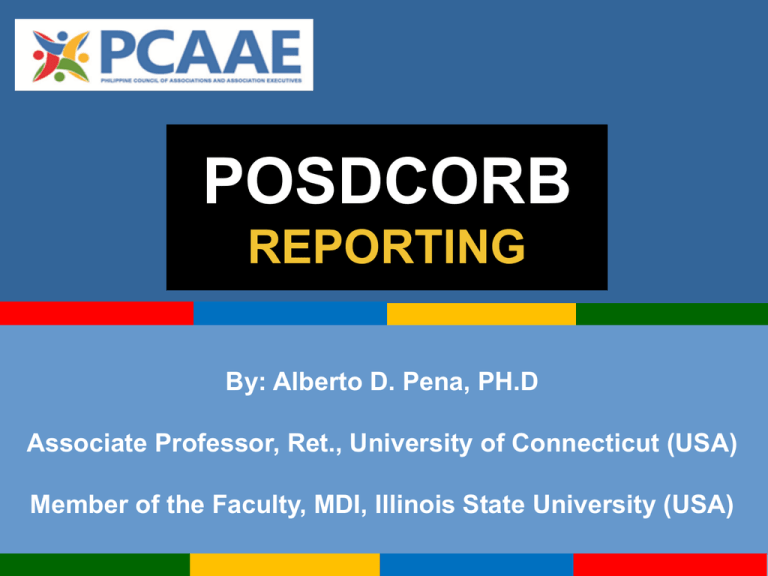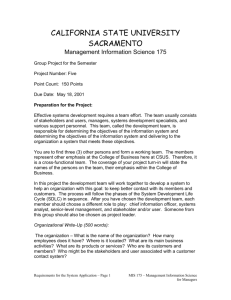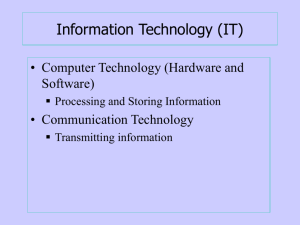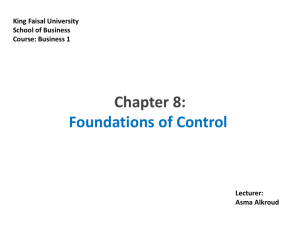Strips Blue Template
advertisement

POSDCORB REPORTING By: Alberto D. Pena, PH.D Associate Professor, Ret., University of Connecticut (USA) Member of the Faculty, MDI, Illinois State University (USA) POSDCORB-REPORTING • In POSDCORB, reporting is the process of keeping the executives informed and in control. • In this context the subordinates makes periodic reports regarding the progress and status of on-going activities in the implementation of the operational plan. • Following the organizational chart the reports comes from lower positions to higher positions going thru the chain of command. POSDCORB-REPORTING • Reporting is normally identified with the flow of organizational communication between positions in the organizational chart. • It could be from bottom to top, from top to bottom, and even lateral. • Executives should see to it that these flows are not impeded. • Some people believe that the communication from top to bottom are not really considered reports. POSDCORB-REPORTING • This flow of communication from top to bottom are in forms of orders, commands or even advice as a result of perusing through the reports from the subordinates. • Communication flow from the top may also be in a form of summarizing all reports submitted from the bottom and transmitted back to all subordinates in the spirit of coordination. POSDCORB-REPORTING • In POSDCORB, it is the flow of communication from bottom to top that is given emphasis. • It takes a form of submitting formal and informal reports from subordinates to supervisors. In a multi-layer organization, the report coming from the bottom will contain more details. • These details should be compiled and organized into fewer categories by the intermediate layers before it is submitted to the higher level manager. • For example the report of an engineer in charge of implementation of a project will contain many details. • Reports from lower units of an Association will also contain many details. POSDCORB-REPORTING • When these reports are received by the chief of the engineering unit (next higher level) the details should be compiled into few categories before submitting it to the Project Manager • The reports from lower levels of an Association it should be summarized before submitting it to the President. • Such details might clog the communication line between the intermediate supervisors and ultimate consumer of the report. • It will even clog the mind of executives along the chain of commands. POSDCORB-REPORTING • The most important information for the Project Manager will be the rate of completion for each component, the rate of completion for the whole project, and the total financial resources so far expended. • The President of an Association will mostly interested in the completion of important activities and the financial resources expended. • The amount of details should be minimized as the report goes upward. • The President can always ask for details whenever it is needed. POSDCORB-REPORTING • The flow of communication from top to bottom will take a form of informing the different subordinates about the overall project completion and how the project is being implemented according to the plan. • These memoranda from the President of the company are important since each subordinate is working on specific function or component of the project. • People below will be more motivated if they are apprised of the overall progress of the project, including successes and failures. POSDCORB-REPORTING • The communication from top to bottom can also take a form of asking for specific details. • This direction of communication will also take a form of order or instructions to specific subordinates. • In some cases it takes a form of feedback and solution to a problems brought by the subordinates. POSDCORB-REPORTING • The lateral communication takes place between co-equals or between positions in the same level of organizational chart. • This communication is for consultation and sharing of information. • Lateral communication also happens between a top executive of one organization and top executives of other organizations. • In program management lateral communications happen between managers of different projects. POSDCORB-REPORTING • The instrument of Reporting in the POSDCORB is Monitoring and Control. • Monitoring and controlling are important functions in day-today management of an organization and during the implementation and operation of programs or projects. • Their purpose is to ensure that activities are being implemented according to the plan and desired outputs are being produced in anticipated quantity and quality. • Any deviation beyond acceptable limits requires corrective action from authorized persons. POSDCORB-REPORTING • The process of gathering, storing, and reporting relevant information is called monitoring and the process of making corrective action is called controlling. • Some people view monitoring and controlling as two separate functions when in reality they are not. • They are so intertwined that they can be viewed as one integrated activity. This is what is known as Management Information System (MIS). POSDCORB-REPORTING POSDCORB-REPORTING WHAT IS BEING MONITORED AND CONTROLLED • The planning process is expected to reflect the most efficient utilization of inputs and effective production of desired outputs. • During implementation, managers should see to it that inputs are being utilized according to the plan and desired outputs are being produced. • When unacceptable deviations are observed, either in the utilization of inputs or in the production of outputs, managers should make corrective actions. • Such actions may involve changing the whole plan. POSDCORB-REPORTING • Inputs consist of funds, materials, personnel, time, technology, and other organizational resources. • Management combines these resources to produce products and services. • What is being monitored and controlled is the amount and manner by which inputs are being used and • The quantity and quality of outputs that are being produced. POSDCORB-REPORTING WHO MONITORS AND WHO CONTROLS • Persons who have access to information do the monitoring, and persons who have the authority to commit organizational resources do the controlling. • Depending on the size of the organization or a project, monitoring and controlling could be done by one person or by different persons. • In large organizations there could a separate research and monitoring unit. POSDCORB-REPORTING MONITORING AND CONTROLLING AS A SYSTEM • Monitoring and controlling involve a number of interrelated functions and considered to be a complete managerial system. • Some managers call it monitoring and control system (MCS), some call it project reporting system (PRS), and some people simply call it information management system (MIS). • For the purpose of this material, we will call it Management Information System (MIS). POSDCORB-REPORTING….. A Management Information System has the following components: • Gathering of information from implementers • Relaying information to decision makers • Making adjustment decisions • Storing information for reference POSDCORB-REPORTING • Information can be stored in record files or in computer memories. • Whatever method is used, managers should be able to retrieve information when needed. • Before storing information however, it should be compiled and reported to whoever is responsible for knowing and controlling the progress of project implementation. • Briefing rooms or conference rooms are ideal places to put visual and graphic compilation of progress reports. • Compilations could also be placed in briefing folders or shown in computer displays. • Compilations should be up-dated from time to time to serve as focal points of comparison between the progress of implementation and the plan. POSDCORB-REPORTING • Information is gathered through verbal and written reports. • Written reports are preferred since they are easily retrieved as records. • In gathering information, make note of the fact that excess information is as bad as lack of it. • In most cases, information overload causes the system to break. • As a rule, only relevant information should be gathered and reported. • In reporting, standardized report formats are recommended since they facilitate storage and compilation. POSDCORB-REPORTING APPLICATIONS OF MANAGEMENT INFORMATION SYSTEMS • MIS has two main applications: 1) Tracking the status of day-to-day management of an organization, and 2) Appraising the progress of project implementation. • Although the MIS model is the same in both applications, the latter is more time-bound than the former. POSDCORB-REPORTING • In day-to-day management of an organization, MIS should focus on: 1) Amount and Condition of Inputs, 2) Achievements in Selected Key Result Areas, and 3) Cost Control Measures. POSDCORB-REPORTING 1. Amount and Condition of Inputs: • MIS should track the condition and level of inputs being utilized. • For example, the Minister or the Permanent Secretary of the Ministry of Education should be informed on the total budget (fund input) of the Ministry and how it is allocated to various programs in different regions and school districts in the country. • Executives of Associations should monitor the level of expenditures to check whether disbursements and obligations are still within the budgeted amount. • He or she would also be interested in knowing the total number of personnel in the organization (human resource input) by categories. POSDCORB-REPORTING 2. Achievement in Key Result Areas (KRA): • MIS should track the level of achievement in selected KRAs. • Key Result Areas are operational areas wherein managers could stake their claims of success or feel the agony of failure. • In the Ministry of Education for example, Key Result Areas would include literacy rate; pupil’s performance in reading, writing, and arithmetic; and other areas. • The Ministry of Education sets achievement targets on these areas to monitor performance. POSDCORB-REPORTING 3. Cost Control Measures: • In addition to knowing the level and condition of inputs and level of achievement in key result areas, management should be informed on the level of efficiency of input utilization. • Efficiency is best measured by relating cost with production of products or services. • An organization that can produce two units of products per unit of cost is considered efficient compared to an organization that needs two units of costs to produce the same amount of product or services. POSDCORB-REPORTING • These ratios are known as cost control measures. • In Associations for example, the executive should know the cost per dollar raised in fund raising campaigns, cost per client served, cost of utilities, etc. • By comparing these figures to similar costs in other organizations and cost in “normal” operation the executive would know if the budget of the organization is being utilized efficiently. • With this knowledge, the executive could make some adjustments to "control" these operational costs. POSDCORB-REPORTING APPLICATION OF MIS IN PROJECT IMPLEMENTATION • A project is a set of related activities that were given separate allocation of resources for the purpose of achieving specific objectives. • It is being implemented and utilized within specific time frame. • Projects require special attention from management. • Project management differs from the day-to-day management in the sense that the former is considered special and the latter is considered routine. POSDCORB-REPORTING • Examples include Adult Literacy Project in the Ministry of Education and holding a “Jamboree” by the Boy Scouts of the Philippines. • Project management revolves around the life of the project which is time-bound. • A project undergoes a cycle of gestation, operation, and evaluation. POSDCORB-REPORTING • The gestation period is the duration of time when the project idea is conceived up to the time the project is implemented. • The planning period is the time when the project is defined, analyzed, and appraised. • The implementation period is the time when the different components in the proposed project are being procured, installed, or constructed. POSDCORB-REPORTING • For example the implementation of the Adult Literacy Project involves the actual training of teachers and volunteers who are involved in the project, • actual purchase of vehicles and audio-visual equipment, • actual construction of village centers to be used as night schools, • and the actual purchase and reproduction of education materials. POSDCORB-REPORTING • The operation or utility period is the span of time when the project is being operated (as in industrial plants) or being utilized (as in adult literacy project), or being conducted (as in the Jamboree Project). • Within this period, the project is expected to produce certain products certain results. • The utility period for the Adult Literacy Project could be 5 years depending on the agreement between the sponsors of the project. • The operation period for the Jamboree Project could be in weeks. • After this period, the project is considered dead unless revived or continued. POSDCORB-REPORTING HOW TO DEVELOP A MANAGEMENT INFORMATION SYSTEM • This section illustrates a simple procedure for developing a functional MC system for the implementation and operation in organizational management or management of projects. • Although the procedure is the same for both periods, the focus of monitoring and control during implementation is input utilization. • The primary concern during the operation period is the quantity and quality of outputs. POSDCORB-REPORTING The procedure involves the following steps: 1) developing standard report forms, 2) developing standard performance criteria, 3) developing a method of compiling and presenting information to decision makers, 4) determining the range of acceptable deviation for comparing plans and performance, and 5) pre-determining corrective actions. POSDCORB-REPORTING 1) DEVELOPING STANDARD REPORT FORMS • The purpose of reporting is to relay relevant information to decision makers. • The forms serve as guides on the kind of data to be gathered. It could provide instructions on how the data should be gathered. • Reporters and reportees should agree on what information are important and which are not. • After determining the kind of information to be reported, standard report forms can be developed for easier recording and correspondence. • As a rule of thumb, report forms should contain few selected information about the progress of on-going activities. POSDCORB-REPORTING • Putting too much information in a form, though sometimes useful, may defeat the purpose of orderly recording, easy retrieval, and timely transmission of critical data. • In many instances, it may even cause the information system to break. • If the manager feels the need for additional information, he/she can always ask field workers. POSDCORB-REPORTING Here are some guidelines on what information to gather and how they should be reported: • Information about Personnel: Information about personnel is useful for project management as well as organizational management. • Regarding personnel, managers may be interested in knowing behaviors that affect performance as well as actual performance of employees. • High rates of absenteeism, tardiness, and falling productivity are preludes to disaster if corrective actions are not taken. • Besides their short term affects, these indicators of personnel performance have serious long term implications. POSDCORB-REPORTING • Absolute numbers, ratios, percentages, and easy-tounderstand descriptors can be used to report information on personnel. • For example, absenteeism of employees can be presented as a ratio between the number of days they were absent and total working days in a certain period. • If the manager is interested in the absenteeism rate of the whole group (a crew, unit, task force, etc.) aggregate attendance should be used. POSDCORB-REPORTING • Report on personnel continued…. • Increasing man-hour losses; which of course transforms into lower productivity, indicates that there is something wrong, or to put it mildly, things are not going right. • To appraise the general morale of the employees, supervisors can use descriptors such as good or bad or an appraisal scale of 1-5, designating number 1 or 5 as bad or good. POSDCORB-REPORTING • In addition to personnel information mentioned above, it is important for managers to simply know who is doing what and who is responsible. • It provides them with sense of control. It also makes monitoring of personnel behavior easier. • By delineating responsibilities, managers can pinpoint impending bottlenecks. POSDCORB-REPORTING b) Information about Funds • One of the most important information managers should monitor is expenditure. • More too often, managers found themselves in an embarrassing situation in not being able to pay project obligations because of delays in fund releases. • In some cases, some activities or projects were stopped because they simply ran out of money. POSDCORB-REPORTING • Legal provisions, auditing rules, complicated supplemental allocation procedures, and long red tapes in the release of allocated funds are reasons enough to anticipate spending levels. • The budget contains the planned expenditures. • It is the basis for monitoring actual spending. • Since budgets are presented in different forms, report forms should conform to budget formats. POSDCORB-REPORTING • Report on funds continued… • There are many "totals" that should be monitored and controlled. Some of these totals are: • line-item totals (if line budgeting is used), • overall total expenditures at a given point in time, • total unpaid obligations, and • other finance-related totals. POSDCORB-REPORTING • Managers should compare actual expenditures with budget allocation in order to determine a) whether activities are being implemented within allocations, b) whether previous estimates are too low or too high, and c) whether the remaining budget is enough to finance remaining time in the year or to complete the project. d) Requests for additional allocation take time. POSDCORB-REPORTING c) Information about Equipment • In varying degrees, persons need machines in almost all productive endeavors. • Yet, many managers tend to ignore the importance of keeping these gadgets in good working condition. • One important piece of information about equipment is its economic life. POSDCORB-REPORTING Other useful information about equipment includes the following: 1) Duration of time the equipment is in actual use. • This is especially important in equipment with very limited life span as in the case of most electronic equipment. 2) The condition of the equipment. It is misleading to assume that five computers (or any equipment for that matter) are available when three of them are out of commission or even obsolete. 3) Record of equipment repairs. The frequency of equipment breakdown gives a clue of its reliability. • The record of equipment repair will also identify parts that should be replaced occasionally. These parts should be kept in stock if possible. POSDCORB-REPORTING d) Information about Time • Time is a very important resource. • The sequential nature of activities makes proper timing critical in management. • The importance of meeting deadlines needs no lengthy elaboration. • Managers should monitor the progress of work, expenditures, personnel well-being, and the condition of critical equipment over a period of time • This to appraise activity or project implementation at a given point in time. POSDCORB-REPORTING d) Information about Time….. • By comparing actual performance with the plan, managers can determine whether the implementation of activities or project is on time, not on time, or ahead of time. • One important piece of information that relates the progress of project implementation is the percentage of completion for the whole project and for each major activity. POSDCORB-REPORTING 2) DEVELOPING STANDARD PERFORMANCE CRITERIA (SPC) • Standard performance criteria (SPC) are yardsticks by which progress of project implementation is measured. • Serving as focal points of comparison in determining possible deviation, SPCs should be consistent with standard report forms discussed earlier. • Standard performance criteria should be developed for both inputs and outputs. • Normally set during the conduct of cost-effectiveness analysis, SPCs reflect the most efficient input utilization and the most cost-effective way to produce output. POSDCORB-REPORTING The following are important performance criteria: a) Pre-determined percentage of completion in different periods of time. b) Estimated level of total expenditure in different periods of time. c) Estimated total expenditure for each activity. d) Number or percentage of equipment in good running condition in different periods of time. f) Expected level of individual performance. g) Estimated amount of supplies and other important materials in stock. h) Normal man-hour loss due to absenteeism and tardiness. POSDCORB-REPORTING 3) DEVELOPING A METHOD FOR COMPILING AND PRESENTING INFORMATION TO DECISION MAKERS • As soon as progress reports are received, relevant information should be compiled and presented to decision-makers. • This should be done to enable managers to compare actual performance with plans. • Summary reports, computer displays and printouts, use of progress charts and tables, network diagrams, and similar presentations can be used. • In most cases, simple summary of progress reports may be adequate in determining progress of implementation. POSDCORB-REPORTING • Large and complex undertaking may need a more sophisticated computerized compilation of data that managers can display on their computer monitor screens. • Computers can also be programmed to remind managers of critical decision areas. • In day-to-day management, statistical charts and tables are very useful. • In project management, one technique that has been proven effective in presenting progress of implementation is PERT/CPM (Project Evaluation Review Technique using Critical Path Method POSDCORB-REPORTING 4) DETERMINING RANGES OF ACCEPTABLE DEVIATION • Unless there are serious symptoms indicating that an activity or a project is not being implemented as planned or • targets in key result areas are not being met, managers need not be alarmed. • Managers of multi-level organizations may also delegate corrective decision-making to their subordinates. • But, how can we determine the seriousness of deviations? POSDCORB-REPORTING DETERMINING RANGES OF ACCEPTABLE DEVIATION…. • Let me use simple examples to illustrate this point. • A cold can be a symptom that there is something wrong with your health. Sneezing, stuffy nose, and loss of appetite may not alarm you, since it is fairly common. • However, you may need to consult a physician, if you run a high fever and have difficulty in breathing. • On the other hand, it is also possible that your fever is not high enough to be concerned. • However, it is surely alarming if your fever persists for a prolonged period of time. POSDCORB-REPORTING • The above examples tell us that the seriousness of deviations depend on its magnitude and frequency. • In order to avoid panic, managers should pre-determine acceptable ranges of deviations. • As a rule of thumb, managers should consider it normal, and as such there is no need for corrective action, if the observed deviation is within the acceptable range. POSDCORB-REPORTING 5) DETERMINING DECISION POINTS • Managers should anticipate possible decisions if deviations go beyond the acceptable range. • These are called decision points. • A decision point has three elements, namely: • 1) identifying the persons who will make the decision, • 2) defining their area of discretion, and • 3) enumeration of possible courses of action. POSDCORB-REPORTING • Decision points minimize confusion, panic, and waste of managerial time. • They identify who will make what decision within the limit of authority. • Decision points also enumerate possible courses of action open to managers. • By scanning predetermined alternatives, managers can systematically decide on corrective actions. POSDCORB-REPORTING • The implementation of corrective action is monitored again through standard reports. • Relevant data will be compiled and compared with predetermined performance criteria, • and if everything goes well, managers can start to relax until the observed deviation goes beyond its acceptable range. • At this point, the monitoring and control system has gone full cycle.







